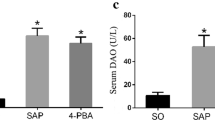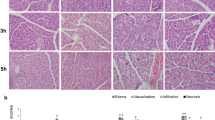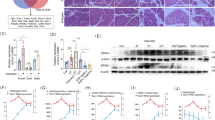Abstract
We aimed to investigate the relationship between the synthesis of hydrogen sulfide (H2S) and the pancreatic acinar cell apoptosis in severe acute pancreatitis (SAP) rats, as well as analyse the potential apoptotic pathway involved in this process. Sixty rats had been equally divided into four groups: sham, SAP, SAP + sodium hydrosulfide (NaHS) and SAP + DL-propargylglycine (PAG). 24 h after SAP induction, all surviving animals of each group were sacrificed to collect blood and tissue samples for the following measurements: the level of serum H2S as well as the levels of tumor necrosis factor-alpha (TNF-α), interleukin-10 (IL-10), H2S synthesizing activity, CSE mRNA and protein expression, maleic dialdehyde (MDA) and myeloperoxidase (MPO) activity, the expression of Bax, Bcl-2, caspase-3, -8 and -9, the release of cytochrome c and the activation of nuclear factor-kappa B (NF-κB), ERK1/2, JNK1/2 and p38 in pancreas. Furthermore, in situ detection of cell apoptosis was examined and the severity of pancreatic damage was analyzed by pathological grading and scoring. Results Significant differences in every index except IL-10 had been found between the SAP, NaHS and PAG groups (P < 0.05). Treatment with PAG obviously induced the pancreatic acinar cell apoptosis as well as improved all the pathological changes and inflammatory parameters. In contrast, administration of NaHS significantly attenuated apoptosis in the pancreas and aggravated the severity of pancreatic damage. Moreover, the expressions of caspase-3, -8, -9 and the release of cytochrome c were all increased in the apoptotic cells, and the activity of NF-κB as well as the phosphorylation of ERK1/2, JNK1/2 and p38 decreased accompanying with the reduction of the serum H2S level. H2S plays a pivotal role in the regulation of pancreatic acinar cell apoptosis in SAP rats. The present results showed that inhibition of H2S synthesis provided protection for SAP rats via inducing acinar cell apoptosis. This process acted through both extrinsic and intrinsic apoptotic pathways, and may be regulated by reducing the activity of NF-κB.






Similar content being viewed by others
References
Chen P, Sun B, Chen H, Wang G, Pan S, Kong R, Bai X, Wang S (2010) Effects of carbon monoxide releasing molecule-liberated CO on severe acute pancreatitis in rats. Cytokine 49(1):15–23
Escobar J, Pereda J, Arduini A, Sandoval J, Sabater L, Aparisi L, Vento M, López-Rodas G, Sastre J (2010) Role of redox signaling, protein phosphatases and histone acetylation in the inflammatory cascade in acute pancreatitis: therapeutic implications. Inflamm Allergy Drug Targets 9(2):97–108
Melino G, Knight RA, Nicotera P (2005) How many ways to die? How many different models of cell death? Cell Death Differ 12(Suppl 2):1457–1462
Criddle DN, Gerasimenko JV, Baumgartner HK, Jaffar M, Voronina S, Sutton R, Petersen OH, Gerasimenko OV (2007) Calcium signalling and pancreatic cell death: apoptosis or necrosis? Cell Death Differ 14(7):1285–1294
Zhang XP, Lin Q, Zhou YF (2007) Progress of study on the relationship between mediators of inflammation and apoptosis in acute pancreatitis. Dig Dis Sci 52(5):1199–1205
Cao Y, Adhikari S, Ang AD, Moore PK, Bhatia M (2006) Mechanism of induction of pancreatic acinar cell apoptosis by hydrogen sulfide. Am J Physiol Cell Physiol 291(3):503–510
Kobayashi C, Yaegaki K, Calenic B, Ishkitiev N, Imai T, Ii H, Aoyama I, Kobayashi H, Izumi Y, Haapasalo M (2011) Hydrogen sulfide causes apoptosis in human pulp stem cells. J Endod 37(4):479–484
Chen H, Sun B, Pan S, Jiang H, Sun X (2009) Dihydroartemisinin inhibits growth of pancreatic cancer cells in vitro and in vivo. Anticancer Drugs 20(2):131–140
McHugh P, Turina M (2006) Apoptosis and necrosis: a review for surgeons. Surg Infect (Larchmt) 7(1):53–68
Takeyama Y (2005) Significance of apoptotic cell death in systemic complications with severe acute pancreatitis. J Gastroenterol 40(1):1–10
Wagner F, Asfar P, Calzia E, Radermacher P, Szabó C (2009) Bench-to-bedside review: hydrogen sulfide—the third gaseous transmitter: applications for critical care. Crit Care 13(3):213
Bhatia M, Sidhapuriwala JN, Ng SW, Tamizhselvi R, Moochhala SM (2008) Pro-inflammatory effects of hydrogen sulphide on substance P in caerulein-induced acute pancreatitis. J Cell Mol Med 12(2):580–590
Tamizhselvi R, Shrivastava P, Koh YH, Zhang H, Bhatia M (2011) Preprotachykinin-A gene deletion regulates hydrogen sulfide-induced toll-like receptor 4 signaling pathway in cerulein-treated pancreatic acinar cells. Pancreas 40(3):444–452
Bhatia M, Wong FL, Fu D, Lau HY, Moochhala SM, Moore PK (2005) Role of hydrogen sulfide in acute pancreatitis and associated lung injury. FASEB J 19(6):623–625
Gu X, Zhu YZ (2011) Therapeutic applications of organosulfur compounds as novel hydrogen sulfide donors and/or mediators. Expert Rev Clin Pharmacol 4(1):123–133
Hegde A, Bhatia M (2011) Hydrogen sulfide in inflammation: friend or foe? Inflamm Allergy Drug Targets 10(2):118–122
Whiteman M, Winyard PG (2011) Hydrogen sulfide and inflammation: the good, the bad, the ugly and the promising. Expert Rev Clin Pharmacol 4(1):13–32
Tamizhselvi RMP, Bhatia M (2007) Hydrogen sulfide acts as a mediator of inflammation in acute pancreatitis: in vitro studies using isolated mouse pancreatic acinar cells. J Cell Mol Med 11(2):315–326
Tamizhselvi R, Koh YH, Sun J, Zhang H, Bhatia M (2010) Hydrogen sulfide induces ICAM-1 expression and neutrophil adhesion to caerulein-treated pancreatic acinar cells through NF-kappaB and Src-family kinases pathway. Exp Cell Res 316(9):1625–1636
Biermann J, Lagrèze WA, Schallner N, Schwer CI, Goebel U (2011) Inhalative preconditioning with hydrogen sulfide attenuated apoptosis after retinal ischemia/reperfusion injury. Mol Vis 17:1275–1286
Adhikari S, Bhatia M (2008) H2S-induced pancreatic acinar cell apoptosis is mediated via JNK and p38 MAP kinase. J Cell Mol Med 12(4):1374–1383
Wang G, Sun B, Zhu H, Gao Y, Li X, Xue D, Jiang H (2010) Protective effects of emodin combined with danshensu on experimental severe acute pancreatitis. Inflamm Res 59(6):479–488
Kang K, Zhao M, Jiang H, Tan G, Pan S, Sun X (2009) Role of hydrogen sulfide in hepatic ischemia-reperfusion-induced injury in rats. Liver Transpl 15(10):1306–1314
Livak KJ, Schmittgen TD (2001) Analysis of relative gene expression data using real-time quantitative PCR and the 2(−delta delta C(T)) method. Methods 25(4):402–408
Wang G, Sun B, Gao Y, Meng QH, Jiang HC (2007) The effect of emodin-assisted early enteral nutrition on severe acute pancreatitis and secondary hepatic injury. Mediators Inflamm 2007:29638
Kusske AM, Rongione AJ, Ashley SW, McFadden DW, Reber HA (1996) Interleukin-10 prevents death in lethal necrotizing pancreatitis in mice. Surgery 120(2):284–288
Wang YW, Wang SJ, Zhou YN, Pan SH, Sun B (2012) Escin augments the efficacy of gemcitabine through down-regulation of nuclear factor-κB and nuclear factor-κB-regulated gene products in pancreatic cancer both in vitro and in vivo. J Cancer Res Clin Oncol 138(5):785–797
Tan G, Pan S, Li J, Dong X, Kang K, Zhao M, Jiang X, Kanwar JR, Qiao H, Jiang H, Sun X (2011) Hydrogen sulfide attenuates carbon tetrachloride-induced hepatotoxicity, liver cirrhosis and portal hypertension in rats. PLoS ONE 6(10):e25943
Thrower E, Husain S, Gorelick F (2008) Molecular basis for pancreatitis. Curr Opin Gastroenterol 24(5):580–585
Guzman EA, Rudnicki M (2006) Intricacies of host response in acute pancreatitis. J Am Coll Surg 202(3):509–519
Dawra R, Sah RP, Dudeja V, Rishi L, Talukdar R, Garg P, Saluja AK (2011) Intra-acinar trypsinogen activation mediates early stages of pancreatic injury but not inflammation in mice with acute pancreatitis. Gastroenterology 141(6):2210–2217
Criddle DN, Gillies S, Baumgartner-Wilson HK, Jaffar M, Chinje EC, Passmore S, Chvanov M, Barrow S, Gerasimenko OV, Tepikin AV, Sutton R, Petersen OH (2006) Menadione-induced reactive oxygen species generation via redox cycling promotes apoptosis of murine pancreatic acinar cells. J Biol Chem 281(52):40485–40492
Gukovskaya AS, Vaquero E, Zaninovic V, Gorelick FS, Lusis AJ, Brennan ML, Holland S, Pandol SJ (2002) Neutrophils and NADPH oxidase mediate intrapancreatic trypsin activation in murine experimental acute pancreatitis. Gastroenterology 122(4):974–984
Gukovskaya AS, Pandol SJ (2004) Cell death pathways in pancreatitis and pancreatic cancer. Pancreatology 4(6):567–586
Booth DM, Murphy JA, Mukherjee R, Awais M, Neoptolemos JP, Gerasimenko OV, Tepikin AV, Petersen OH, Sutton R, Criddle DN (2011) Reactive oxygen species induced by bile acid induce apoptosis and protect against necrosis in pancreatic acinar cells. Gastroenterology 140(7):2116–2125
Bhatia M, Wallig MA, Hofbauer B, Lee HS, Frossard JL, Steer ML, Saluja AK (1998) Induction of apoptosis in pancreatic acinar cells reduces the severity of acute pancreatitis. Biochem Biophys Res Commun 246(2):476–483
Mareninova OA, Sung KF, Hong P, Lugea A, Pandol SJ, Gukovsky I, Gukovskaya AS (2006) Cell death in pancreatitis: caspases protect from necrotizing pancreatitis. J Biol Chem 281(6):3370–3381
Nakka VP, Gusain A, Mehta SL, Raghubir R (2008) Molecular mechanisms of apoptosis in cerebral ischemia: multiple neuroprotective opportunities. Mol Neurobiol 37(1):7–38
Escobar J, Pereda J, Arduini A, Sandoval J, Sabater L, Aparisi L, López-Rodas G, Sastre J (2009) Cross-talk between oxidative stress and pro-inflammatory cytokines in acute pancreatitis: a key role for protein phosphatases. Curr Pharm Des 15(26):3027–3042
Norman J (1998) The role of cytokines in the pathogenesis of acute pancreatitis. Am J Surg 175(1):76–83
Malleo G, Mazzon E, Siriwardena AK, Cuzzocrea S (2007) Role of tumor necrosis factor-alpha in acute pancreatitis: from biological basis to clinical evidence. Shock 28(2):130–140
Wang G, Sun B, Gao Y, Meng QH, Jiang HC (2008) An experimental study of emodin assisted early enteral nutrition for the treatment of severe acute pancreatitis. Hepatogastroenterology 55(81):33–40
Keceli M, Kucuk C, Sozuer E, Kerek M, Ince O, Arar M (2005) The effect of interleukin-10 on acute pancreatitis induced by cerulein in a rat experimental model. J Invest Surg 18(1):7–12
Dagvadorj J, Naiki Y, Tumurkhuu G, Hassan F, Islam S, Koide N, Mori I, Yoshida T, Yokochi T (2008) Interleukin-10 inhibits tumor necrosis factor-alpha production in lipopolysaccharide-stimulated RAW 264.7 cells through reduced MyD88 expression. Innate Immun 14(2):109–115
Rakonczay Z Jr, Hegyi P, Takács T, McCarroll J, Saluja AK (2008) The role of NF-kappaB activation in the pathogenesis of acute pancreatitis. Gut 57(2):259–267
Kong R, Sun B, Jiang H, Pan S, Chen H, Wang S, Krissansen GW, Sun X (2010) Downregulation of nuclear factor-kappaB p65 subunit by small interfering RNA synergizes with gemcitabine to inhibit the growth of pancreatic cancer. Cancer Lett 291(1):90–98
Salminen A, Ojala J, Kaarniranta K (2011) Apoptosis and aging: increased resistance to apoptosis enhances the aging process. Cell Mol Life Sci 68(6):1021–1031
Gukovsky I, Reyes CN, Vaquero EC, Gukovskaya AS, Pandol SJ (2003) Curcumin ameliorates ethanol and nonethanol experimental pancreatitis. Am J Physiol Gastrointest Liver Physiol 284(1):G85–G95
Keshet Y, Seger R (2010) The MAP kinase signaling cascades: a system of hundreds of components regulates a diverse array of physiological functions. Methods Mol Biol 661:3–38
Yang X, Zhou G, Ren T, Li H, Zhang Y, Yin D, Qian H, Li Q (2012) β-Arrestin prevents cell apoptosis through pro-apoptotic ERK1/2 and p38 MAPKs and anti-apoptotic Akt pathways. Apoptosis 17(9):1019–1026
Escobar J, Pereda J, López-Rodas G, Sastre J (2012) Redox signaling and histone acetylation in acute pancreatitis. Free Radic Biol Med 52(5):819–837
Junttila MR, Li SP, Westermarck J (2008) Phosphatase-mediated crosstalk between MAPK signaling pathways in the regulation of cell survival. FASEB J 22(4):954–965
Dabrowski A (2003) Exocrine pancreas; molecular basis for intracellular signaling, damage and protection—Polish experience. J Physiol Pharmacol 54(Suppl 3):167–181
Yang G, Yang W, Wu L, Wang R (2007) H2S, endoplasmic reticulum stress, and apoptosis of insulin-secreting beta cells. J Biol Chem 282(22):16567–16576
Zhang LM, Jiang CX, Liu DW (2009) Hydrogen sulfide attenuates neuronal injury induced by vascular dementia via inhibiting apoptosis in rats. Neurochem Res 34(11):1984–1992
Acknowledgments
This paper was supported by grants from the National Natural Scientific Foundation of China (No: 81170431, 81100314, 81101799, 30901437), Postdoctoral Science Foundation of China (No: 2012M511512), Youth Science Foundation of Heilongjiang Province (No: QC2011C036), Postdoctoral Science Foundation of Heilongjiang Provincial Government (No: 90857), Natural Scientific Foundation of Heilongjiang Province (No: D201152) and Research Fund of the First Affiliated Hospital of Harbin Medical University (No: 2009B03).
Conflict of interest
The authors declare no conflict of interest.
Author information
Authors and Affiliations
Corresponding author
Additional information
Gang Wang and Bing Han authors contributed equally to this paper.
Rights and permissions
About this article
Cite this article
Wang, G., Han, B., Zhou, H. et al. Inhibition of hydrogen sulfide synthesis provides protection for severe acute pancreatitis rats via apoptosis pathway. Apoptosis 18, 28–42 (2013). https://doi.org/10.1007/s10495-012-0770-x
Published:
Issue Date:
DOI: https://doi.org/10.1007/s10495-012-0770-x




